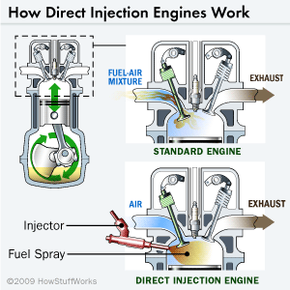Direct Injection Basics
For the lay individual, the labyrinth of hoses, wire harnesses, manifolds and tubing beneath a car hood might appear intimidating. But when it comes to the gasoline engine, just know this: It needs fuel, air (oxygen, to be precise) and spark in order to operate.
The two most critical differences between a direct injection engine and a standard gasoline engine are how they deliver fuel and how the fuel mixes with incoming air. These basic premises make a tremendous difference in an engine's overall efficiency.
Advertisement
Before we look inside the direct injection engine, let's view a quick second in the life of a standard gasoline engine (for a more complete look at the gasoline engine, check out How Car Engines Work). First, the fuel travels via pump from the fuel tank, through the fuel line and into fuel injectors that are mounted into the engine. The injectors spray gasoline into the air intake manifold, where fuel and air mix together into a fine mist. At precisely timed intervals, intake valves open, corresponding to the different cylinders of the engine. As a cylinder's intake valve opens, a piston in that cylinder descends, sucking the fuel-air mist from the air manifold above into the chamber below. As the piston ascends once more, it squeezes (compresses) the fuel-air mix until it is nearly nine times as dense as it was to begin with. Then, that cylinder's designated spark plug fires, igniting the chamber into a high-pressure, high-energy explosion. This little bang pushes the piston back down with tremendous force, causing it to turn the crankshaft and ultimately send power to the wheels.
Got that? Pretty complicated, huh? It works, but from an engineering standpoint, it leaves much to be desired, and it's pretty wasteful.
With a direct injection engine, however, the fuel gets to skip a step and add a bit of efficiency. Instead of hanging out in the air intake manifold, fuel is squirted directly into the combustion chamber. With an assist from modern engine management computers, the fuel gets burned right where it's needed, when it's needed [source: Fueleconomy.gov].
To find out more about what makes direct injection engines more efficient, move on to the next page.
